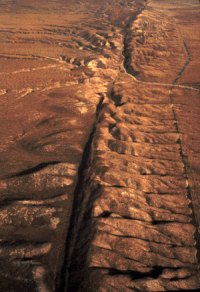Scientists say the Big One could be even bigger

The Big One predicted for the San Andreas fault could end up being bigger than earthquake experts previously thought.
New research shows that a section of the fault is long overdue for a major earthquake.
Some scientists are saying that the southern portion of the fault is capable of a magnitude 8.1 earthquake that could run 340 miles.
That would be significantly stronger and wider than the southern San Andreas' last major rupture, in 1857. Such an earthquake could cause much more damage because its power would be spread over a larger area and the shaking would last longer.
Whether such a quake would happen in our lifetime had been a subject of debate among scientists. Until recently, experts believed that the southern section of the San Andreas, which runs through the Carrizo Plain 100 miles northwest of Los Angeles, would remain dormant for at least another century.
But that hypothesis seemed to be shattered by a recent report in the journal Geology, which said that even that section is far overdue for a major quake.
According to U.S. Geological Survey seismologist Lucy Jones, all 340 miles of the southern San Andreas could rupture.
Such a scenario would trigger a magnitude 8.1 earthquake, said Thomas Jordan, director of the Southern California Earthquake Center, a calculation with which Jones agreed.
"My concern is that we will get a series of large earthquakes along the San Andreas fault," Jordan said.
Jones refers to such a huge earthquake as "wall-to-wall" because it would cover a wide area of Southern California.
The "walls" of the southern San Andreas begin in the Salton Sea and end in Parkfield in Monterey County. Scientists consider the southern San Andreas fault as one segment generally because it behaves the same -- it rarely rumbles, but when awakened, the shaking can be devastating.
In contrast, the section of the fault north of Parkfield behaves differently. That section moves at a constant creep; because stress is relieved regularly, large quakes don't occur there.
In 1857, an estimated magnitude 7.9 quake ruptured 200 miles of fault between Monterey and San Bernardino counties. It wasn't a wall-to-wall quake; it stopped around the Cajon Pass, probably because the fault south of that area had ruptured just a few decades earlier, in 1812, Jones said. Because the 1812 quake had relieved tectonic tension in the Cajon Pass, it effectively stopped the 1857 quake from moving further south.
"Can I imagine the 1857 earthquake happening again and stopping at the Cajon Pass? Probably not," Jones said. "Once you have a big slip, you're more likely to move along down the fault," Jones said. "If the rupture has been made . . . that's a lot of momentum that will keep the rupture moving down the fault."
The San Andreas has long been considered one of the most dangerous faults in Southern California because of its length. Not only do longer faults produce bigger quakes, but their shaking also emits a type of energy that can travel longer distances.
"A much larger area is affected by a really large earthquake," Jones said.
(c) 2010, Los Angeles Times.
Distributed by McClatchy-Tribune Information Services.

















